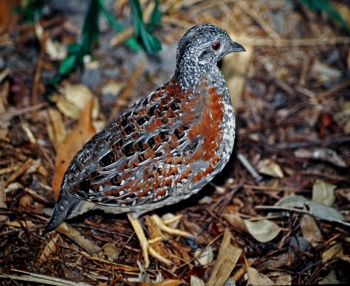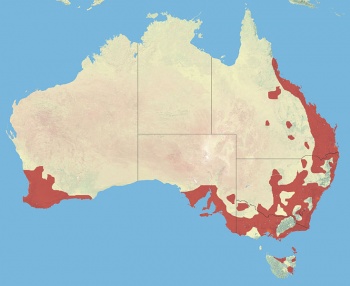(split New Caledonian Buttonquail, GS) |
|||
| (12 intermediate revisions by 7 users not shown) | |||
| Line 1: | Line 1: | ||
| − | + | [[Image:63A8188.jpg|thumb|550px|right|Male<br />Photo by {{user|Stephen+Powell|Stephen Powell}}<br />Stawell, [[Victoria]], [[Australia]], September 2015]] | |
| − | + | ;[[:Category:Turnix|Turnix]] varius | |
| − | [[Image: | + | ''Turnix varia'' |
==Identification== | ==Identification== | ||
| − | + | [[Image:Painted-Button-Quail-fem.jpg|thumb|350px|right|Female<br />Photo by '''[http://www.birdforum.net/member.php?u=49168 Hans&Judy Beste]'''<br />Victoria, [[Australia]]]] | |
| − | + | 17–23 cm (6¾-9 in)<br /> | |
| + | *Reddish-brown overall plumage | ||
| + | *Pale spots on forehead and breast | ||
| + | *Red eye | ||
| + | *Chestnut shoulders<br /> | ||
| + | Female is brighter than the male. <br /> | ||
| + | Juvenile is smaller and grey, more mottled, pale eyes. | ||
==Distribution== | ==Distribution== | ||
| − | + | {| cellpadding="5" | |
| + | |- | ||
| + | | rowspan=2 valign="center"| | ||
| + | [[Image:Map-Painted Button-Quail.jpg|350px|left]] | ||
| + | |[[Australia]] and [[Tasmania]] | ||
| + | |- | ||
| + | | | ||
| + | |} | ||
| + | ==Taxonomy== | ||
| + | Forms a [[Dictionary_P-S#S|superspecies]] with [[Buff-breasted Buttonquail]], [[Chestnut-backed Buttonquail]] and [[New Caledonian Buttonquail]]. | ||
| − | == | + | The scientific name was formerly spelled ''varia''. |
| + | ====Subspecies==== | ||
| + | Two subspecies are recognized<sup>[[#References|[1]]]</sup>. | ||
| + | *''T. v. scintillans'' - Houtman Abrolhos Islands (off sw Australia) | ||
| + | *''T. v. varius'' - SW, e and se [[Australia]] and Tasmania | ||
==Habitat== | ==Habitat== | ||
| − | Scrub, grassy woodland, open | + | Scrub, grassy woodland, open banksia, eucalypt and acacia forests, grassy clearings in dense forest, and heath. |
==Behaviour== | ==Behaviour== | ||
| − | + | ====Diet==== | |
| − | + | There is not a lot known, however, grass seeds, insects and fruits are known to be consumed. | |
| − | + | ====Breeding==== | |
| + | [[Dictionary_P-S#P|Polyandrous]]. The clutch consists of 3-4 eggs which are incubated by the male for 13-14 days. They are fed by the male and reach adulthood in 23 days. | ||
| + | ==References== | ||
| + | #{{Ref-Clements6thAug17}}#Handbook of the Birds of the World Alive (retrieved Nov 2017) | ||
| + | #Birdata.com.au, Raw Data for Map | ||
| + | #Wikipedia | ||
| + | #BirdForum member observations | ||
| + | {{ref}} | ||
| + | ==External Links== | ||
| + | {{GSearch|"Turnix varius" {{!}} "Turnix varia" {{!}} "Painted Buttonquail"}} | ||
| + | {{GS-checked}}<br /><br /> | ||
| − | + | [[Category:Birds]][[Category:Turnix]] | |
| − | |||
| − | |||
| − | [[Category: | ||
Latest revision as of 16:25, 7 January 2023
- Turnix varius
Turnix varia
Identification
17–23 cm (6¾-9 in)
- Reddish-brown overall plumage
- Pale spots on forehead and breast
- Red eye
- Chestnut shoulders
Female is brighter than the male.
Juvenile is smaller and grey, more mottled, pale eyes.
Distribution
| Australia and Tasmania | |
Taxonomy
Forms a superspecies with Buff-breasted Buttonquail, Chestnut-backed Buttonquail and New Caledonian Buttonquail.
The scientific name was formerly spelled varia.
Subspecies
Two subspecies are recognized[1].
- T. v. scintillans - Houtman Abrolhos Islands (off sw Australia)
- T. v. varius - SW, e and se Australia and Tasmania
Habitat
Scrub, grassy woodland, open banksia, eucalypt and acacia forests, grassy clearings in dense forest, and heath.
Behaviour
Diet
There is not a lot known, however, grass seeds, insects and fruits are known to be consumed.
Breeding
Polyandrous. The clutch consists of 3-4 eggs which are incubated by the male for 13-14 days. They are fed by the male and reach adulthood in 23 days.
References
- Clements, J. F., T. S. Schulenberg, M. J. Iliff, D. Roberson, T. A. Fredericks, B. L. Sullivan, and C. L. Wood. 2017. The eBird/Clements checklist of birds of the world: v2017, with updates to August 2017. Downloaded from http://www.birds.cornell.edu/clementschecklist/download/
- Handbook of the Birds of the World Alive (retrieved Nov 2017)
- Birdata.com.au, Raw Data for Map
- Wikipedia
- BirdForum member observations
Recommended Citation
- BirdForum Opus contributors. (2024) Painted Buttonquail. In: BirdForum, the forum for wild birds and birding. Retrieved 16 June 2024 from https://www.birdforum.net/opus/Painted_Buttonquail
External Links
GSearch checked for 2020 platform.






